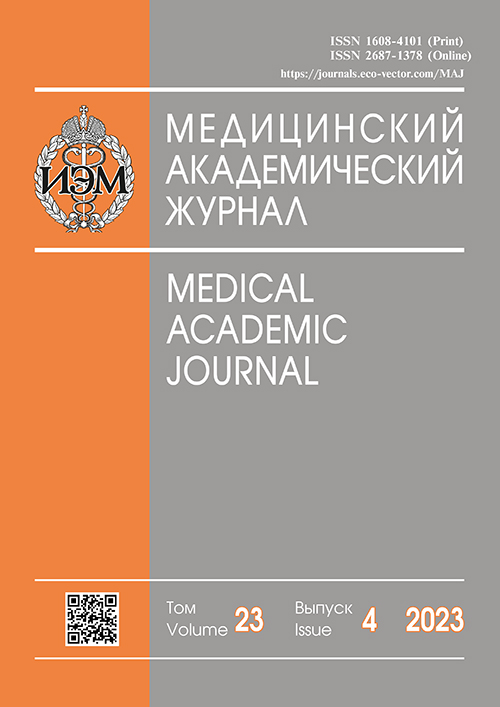Immune response and laboratory markers in the spectrum of severity of COVID-19
- Authors: Desheva Y.A.1,2, Shvedova T.N.3, Kudar P.A.1, Petrachkova D.S.1, Lerner A.A.3,4
-
Affiliations:
- Institute of Experimental Medicine
- Saint Petersburg State University
- Vsevolozhsk Clinical Interdistrict Hospital
- North-Western State Medical University named after I.I. Mechnikov
- Issue: Vol 23, No 4 (2023)
- Pages: 85-94
- Section: Clinical research
- Published: 21.12.2023
- URL: https://journals.eco-vector.com/MAJ/article/view/624886
- DOI: https://doi.org/10.17816/MAJ624886
- ID: 624886
Cite item
Abstract
BACKGROUND: Serum antibodies to SARS-CoV-2, when measured early after disease onset, may add value to the diagnosis of COVID-19.
AIM: To examine the levels of serum antibodies to SARS-CoV-2 and laboratory blood parameters in hospitalized patients with COVID-19 of varying severity.
MATERIALS AND METHODS: In this retrospective cohort study, we examined laboratory markers of inflammation in patients with acute COVID-19 during the 1st week of hospitalization. The levels of serum antibodies to SARS-CoV-2 were studied using commercial test systems.
RESULTS: In 47% of hospitalized patients with COVID-19, during the first week of hospital stay, IgM and IgG antibodies to SARS-CoV-2 were detected, both in the case of a positive and negative PCR test. An average positive cor- relation of detected IgM and IgG with antibodies to the receptor-binding site of the S-protein of the SARS-CoV-2 virus is shown. In total, IgM and IgG antibodies to SARS-CoV-2 were most often detected in patients with a favorable course of the disease. Laboratory parameters in patients with moderate and severe COVID-19 were characterized by a significant increase in the level of serum C-reactive protein, an increase in the neutrophil-leukocyte ratio and fibrinogen level, in comparison with data from patients with a mild course of the disease. In mild cases of infection, a moderately negative correlation was revealed between the levels of antibodies to SARS-CoV-2 and NLR.
CONCLUSIONS: Detection of antibodies to SARS-CoV-2 in the early stages of hospitalization may be a predictor of a favorable outcome of the disease and serve as an additional criterion for the diagnosis of COVID-19 along with PCR analysis.
Keywords
Full Text
About the authors
Yulia A. Desheva
Institute of Experimental Medicine; Saint Petersburg State University
Email: desheva@mail.ru
ORCID iD: 0000-0001-9794-3520
SPIN-code: 4881-3786
Scopus Author ID: 9939567500
ResearcherId: I-1493-2013
MD, Dr. Sci. (Med.), Professor of the Department of Fundamental Problems of Medicine and Medical Technologies
Russian Federation, 12 Academician Pavlov St., Saint Petersburg, 197022; Saint PetersburgTamara N. Shvedova
Vsevolozhsk Clinical Interdistrict Hospital
Email: toma_nn@mail.ru
ORCID iD: 0000-0002-6649-8150
Head of the Clinical and Diagnostic Laboratory
Russian Federation, Leningrad RegionPolina A. Kudar
Institute of Experimental Medicine
Email: polina6226@mail.ru
ORCID iD: 0000-0002-3342-5828
Junior Research Associate at the World-Class Scientific Center “Center for Personalized Medicine”
Russian Federation, 12 Academician Pavlov St., Saint Petersburg, 197022Daria S. Petrachkova
Institute of Experimental Medicine
Author for correspondence.
Email: ya.dashook@ya.ru
ORCID iD: 0009-0004-0045-4886
Document specialist of Department of Translational Medicine
Russian Federation, 12 Academician Pavlov St., Saint Petersburg, 197022Anna A. Lerner
Vsevolozhsk Clinical Interdistrict Hospital; North-Western State Medical University named after I.I. Mechnikov
Email: sever67@bk.ru
ORCID iD: 0000-0001-5848-6486
MD, Cand. Sci. (Med.), Doctor of the Clinical Diagnostic Laboratory; Chief Staff Specialist in Clinical Laboratory Diagnostics
Russian Federation, Leningrad Region; Saint PetersburgReferences
- Al-Tamimi M, Tarifi AA, Qaqish A, et al. Immunoglobulins response of COVID-19 patients, COVID-19 vaccine recipients, and random individuals. Plos one. 2023;18(2):e0281689. doi: 10.1371/journal.pone.0281689
- Kirkcaldy RD, King BA, Brooks JT. COVID-19 and postinfection immunity: limited evidence, many remaining questions. JAMA. 2020;323(22):2245–2246. doi: 10.1001/jama.2020.7869
- Rezaei M, Baghaei P, Sadr M, et al. Diagnosis of COVID-19 by serology in admitted patients with negative RT-PCR assay. Iran J Allergy Asthma Immunol. 2021;20(4):394–401.
- Shi J, Zheng J, Tai W, et al. A glycosylated RBD protein induces enhanced neutralizing antibodies against Omicron and other variants with improved protection against SARS-CoV-2 infection. J Virol. 2022;96(17):e0011822. doi: 10.1128/jvi.00118-22
- Pink I, Raupach D, Fuge J, et al. C-reactive protein and procalcitonin for antimicrobial stewardship in COVID-19. Infection. 2021;49(5):935–943. doi: 10.1007/s15010-021-01615-8
- Vafadar Moradi E, Teimouri A, Rezaee R, et al. Increased age, neutrophil-to-lymphocyte ratio (NLR) and white blood cells count are associated with higher COVID-19 mortality. Am J Emerg Med. 2021;40:11–14. doi: 10.1016/j.ajem.2020.12.003
- Wang Y, Kang H, Liu X, Tong Z. Combination of RT-qPCR testing and clinical features for diagnosis of COVID-19 facilitates management of SARS-CoV-2 outbreak. J Med Virol. 2020;92(6):538–539. doi: 10.1002/jmv.25721
- Plūme J, Galvanovskis A, Šmite S, et al. Early and strong antibody responses to SARS-CoV-2 predict disease severity in COVID-19 patients. J Transl Med. 2022;20(1):176. doi: 10.1186/s12967-022-03382-y
- Jurenka J, Nagyová A, Dababseh M, et al. Anti-SARS-CoV-2 antibody status at the time of hospital admission and the prognosis of patients with COVID-19: a prospective observational study. Infect Dis Rep. 2022;14(6):1004–1016. doi: 10.3390/idr14060100
- Kolb P, Giese S, Voll RE, et al. Immune complexes as culprits of immunopathology in severe COVID-19. Med Microbiol Immunol. 2023;212(2):185–191. doi: 10.1007/s00430-022-00743-8
- Lucas C, Klein J, Sundaram ME, et al. Delayed production of neutralizing antibodies correlates with fatal COVID-19. Nat Med. 2021;27(7):1178–1186. doi: 10.1038/s41591-021-01355-0
- Desheva Y, Lerner A, Shvedova T, et al. Pilot study results on antibodies to the S-and N-Proteins of SARS-CoV-2 in paired sera from COVID-19 patients with varying severity. Antibodies (Basel). 2023;12(1):19. doi: 10.3390/antib12010019
- Stringer D, Braude P, Myint PK, et al. The role of C-reactive protein as a prognostic marker in COVID-19. Int J Epidemiol. 2021;50(2):420–429. doi: 10.1093/ije/dyab012
- Fazal M. C-reactive protein a promising biomarker of COVID-19 severity. Korean J Clin Lab Sci. 2021;53(3):201–207. doi: 10.15324/kjcls.2021.53.3.201
- Liu Y, Du X, Chen J, et al. Neutrophil-to-lymphocyte ratio as an independent risk factor for mortality in hospitalized patients with COVID-19. J Infect. 2020;81(1):e6–e12. doi: 10.1016/j.jinf.2020.04.002
Supplementary files










